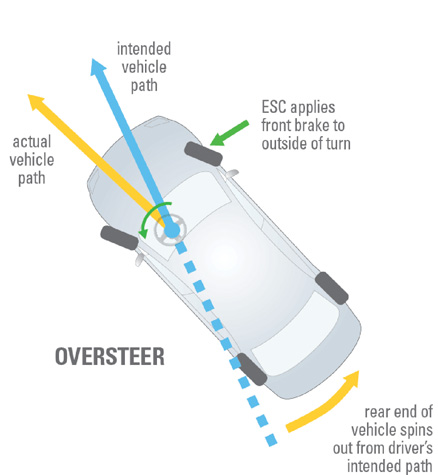
What is electronic stability control (ESC)?
ESC is a vehicle control system comprised of sensors and a microcomputer that continuously monitors how well a vehicle responds to:
This technology helps prevent the sideways skidding and loss of control that can lead to rollovers. It can help drivers maintain control during emergency maneuvers when their vehicles otherwise might spin out, or reduce vehicle speed to prevent running off the outside of a curve.
The systems have been marketed under various names, including dynamic stability control, vehicle stability control and dynamic stability and traction control among others.
How does ESC help drivers maintain control?
A driver loses control when the vehicle goes in a direction different from the one the steering wheel position indicates. This typically occurs when a driver tries to turn very hard or turn on a slippery road. Then the vehicle may understeer or oversteer.
When it oversteers it turns more than the driver intended because the rear end is spinning or sliding out. When a vehicle understeers it turns less than the driver intended and continues in a forward direction because the front wheels have insufficient traction.
ESC can prevent under and oversteer by selectively braking wheels to produce a counteracting force which helps correct the vehicle's direction of travel. In some cases engine throttle also is reduced.


How effective is ESC in preventing crashes?
It reduces the risk of fatal single vehicle rollovers by 75 percent for SUVs and by 72 percent for cars. Federal studies also show large benefits. The National Highway Traffic Safety Administration (NHTSA) estimates the installation of ESC reduces:
Does ESC activate in typical everyday driving?
For most drivers, ESC isn't likely to activate frequently. It won't prevent most of the fender-bender crashes that occur so often in stop and go traffic. For example, it's designed to help a driver in the relatively rare event of loss of control at high speed or on a slippery road.
Does the government require ESC?
As of the 2012 model year, the federal government requires ESC in all cars, SUVs, pickups and minivans. A similar requirement for truck tractors was finalized in 2015. Most new truck tractors will be required to have ESC as of Aug. 1, 2017. The remaining types have until 2019.
How long has ESC been available?
ESC was introduced in 1995 as optional equipment on luxury cars. By the 2001 model year, it was standard on a number of high selling vehicles and available as an option on many more.
NHTSA phased in its ESC rule, requiring the technology on 55 percent of model year 2009 vehicles and increasing the percentage each year until model year 2012, when manufacturers had to equip all their passenger vehicles with ESC. Prior to 2012, the Institute required vehicles to have ESC in order to qualify for a TOP SAFETY PICK award.
Vehicles equipped with electronic stability control:
http://www.iihs.org/iihs/ratings/safety-features
Can ESC help reduce insurance losses?
Yes. Losses under collision coverage are about 15 percent lower for vehicles with ESC than for predecessor models without it, according to an analysis by HLDI. ESC doesn't have much effect on liability claims filed when an at fault driver damages someone else's car or property or the frequency of personal injury claims filed to cover medical expenses.